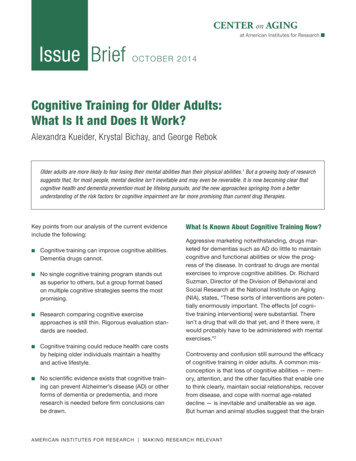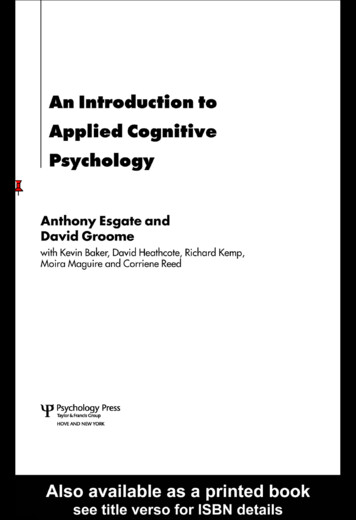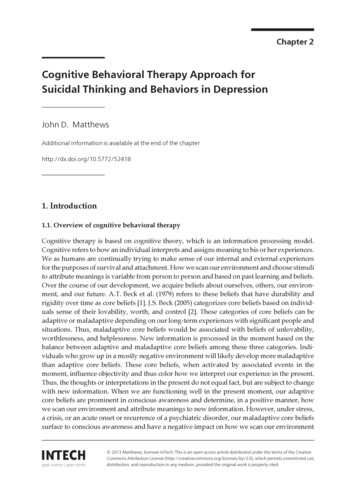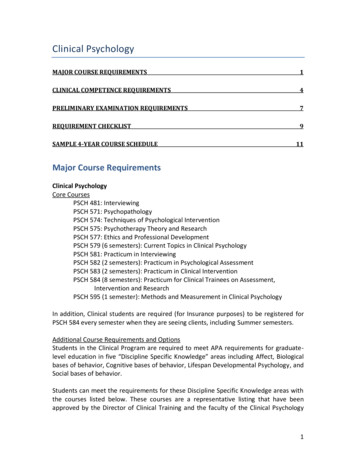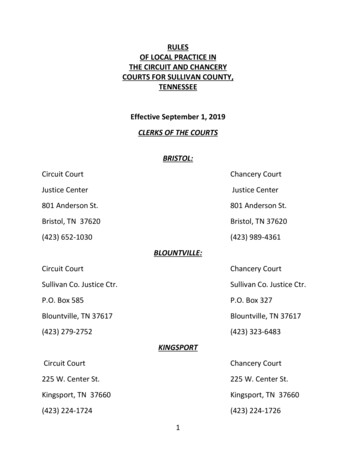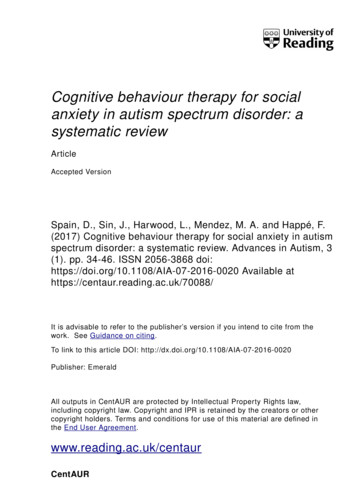
Transcription
Contested Concepts in Cognitive Social ScienceAlan SchwartzUniversity of California, BerkeleyMay 1992Copyright 1992 by Alan Schwartz. All rights reserved.Distribution of any or all of this material is permitted for research or educational purposes,providing it is distributed with this page intact. The publication or sale of this material for profitis strictly prohibited. Requests for reprints can be directed to the author:Alan SchwartzDepartment of Medical Education (mc 591)808 S. Wood St., 986 CMEUniversity of Illinois at ChicagoChicago, IL 60612(e-mail: alansz@uic.edu)
AcknowledgementsA project such as this is never a solitary effort, and I am indebted to a number of people for theirassistance. In particular, I would like to thank: Jane Espenson, who has often helped me better understand the field of linguistics andsparked new ideas. Her comments have been invaluable during the writing of this thesis. Laura Stoker and David Collier of the Department of Political Science at UC Berkeley whosesupport has been unceasing. Alison Gopnik of the Department of Psychology at UC Berkeley, who served as the secondreader for this thesis. The Institute for Cognitive Studies at UC Berkeley, which has provided me with facilities andequipment.Contested Concepts in Cognitive Social Science is dedicated above all to George Lakoff, who isin many ways the founder of the program of cognitive social science. George has given me bothenormous opportunities and a sense of scientific responsibility. I can think of no better mentor.
AbstractConcepts and categories are of critical concern to the social sciences, where there is oftensignificant lack of consensus about the proper definition or application of a concept. It has beensuggested that such conflict results from the nature of the concepts in question (for example,democracy, art, science, or feminism) themselves; concepts which provoke such arguments are saidto be “essentially contested.” (Gallie 1956)By applying the results of cognitive science, particularly cognitive linguistics, to theseconcepts, we discover that they are characterized by oversimplified or clustered idealized cognitivemodels and belief systems which extend and instantiate these models into the full-fledged conceptsused in social science discourse. These extensions may be either principled, based on independentlyexisting belief systems, or ad hoc, based on belief systems specific to the concept in question.This analysis has serious consequences for the social sciences. The objectivist paradigm(Lakoff 1987) which underlies classical social science can not accommodate such cognitively-basedconcepts. Efforts by social scientists to sharpen conceptual discrimination are similarly flawed bythis paradigm. A cognitively-based social science would more accurately reflect the actual processesby which people understand concepts.
Table of ContentsAcknowledgements . 1Abstract . 2Table of Contents . 3Foreword: Cognitive Social Science . 4Brief history of cognitive science . 4Social Science Applications . 6Chapter 1 - The problem of social science concepts . 8The Objectivist Paradigm in Social Science . 9Problems with objectivism . 10Chapter 2 - Contested Concepts . 14The work of W.B.Gallie . 14Connolly’s return to Gallie . 18Chapter 3 - A Cognitive Analysis of Contested Concepts . 20Frame Semantics . 22Metaphor . 23Idealized Cognitive Models. 24Cluster Models . 24Radial Categories . 25An ICM account of Contested Categories . 26Chapter 4 - Social Science’s own attempts: The work of Giovanni Sartori . 34Sartori’s method . 34Philosophical underpinnings . 36Failings of the method . 40Conclusions . 47Feminism: A case study of a contested concept . 49Folk theories of gender . 51Oversimplified Feminism . 55The belief systems and their corresponding feminisms. 56Feminist Methodologies. 65Feminisms and Feminists . 67Entailments in Conflict . 68Bibliography . 72
Foreword: Cognitive Social ScienceBrief history of cognitive scienceSince I began studying cognitive science I have often been asked to explain what thediscipline is about. While cognitive science is still new enough that it is not popularly familiar, itshistory can be traced back to 1641, when Rene Descartes asked the question that has challengedcognitive scientists since: What is the nature of the mental, and how is it related to the physical? Putinto modern terms, how do people perform mental activities (e.g. linguistic communication,thinking, problem-solving, or categorizing), and how are these activities related to the buzz ofneurochemical activity which takes place in the brain?Descartes’ question founded the study of the philosophy of mind. Three answers wereimmediately available: all substance is mental substance (idealism), all substance is physicalsubstance (materialism), and different physical and mental substances exist (dualism). For a numberof reasons, not the least of which are irresolvable difficulties with idealism and dualism, thematerialist account has attained preeminence, and nearly all cognitive scientists accept the material(neurophysiological) basis of the mind.Philosophy has often driven science, and the science of mind was no exception. Thephilosophical revolution of logical-empiricism in the 1930’s and 1940’s shaped the study ofcognition in many important ways. The logical-empiricists’ emphasis on science as a mathematicallyverifiable activity strongly influenced cognitive science, and much cognitive research still positsformal symbol manipulation as the basis of thought and language. This position, however, was notwithout its challengers, of whom J. L. Austin and Ludwig Wittgenstein are the best known.The inauguration of the modern discipline of cognitive science came in 1956, as a result of anumber of significance events. The MIT Symposium on Information Theory that year featuredground-breaking papers by Allen Newell and Herbert Simon (who described their computer programwhich could perform mathematical proofs) and Noam Chomsky. (who proposed that syntax could beformally represented by a system of transformations of linguistic structures.) In addition, a seminalsummer institute at Dartmouth brought together the pioneers of artificial intelligence and establisheda community of researchers into machine thinking. (Gardner 1985:28-3 1)Cognitive research continued through the 1960’s and 1970’s, when it received a major boostfrom the Alfred P. Sloan Foundation, which invested 20 million dollars over seven years in researchgrants. In 1977, the journal Cognitive Science was founded, the society of the same named soonfollowed. (Gardner 1985:36) And field still continues to grow.Cognitive science has applied its interdisciplinary methodology to a number of interestingproblems in cognition, including perception (especially vision), computer reasoning and languageunderstanding, and decision-making and problem-solving.The program of cognitive linguistics, championed by George Lakoff, Charles Fillmore, Eve
Sweetser, Giles Fauconnier, Ron Langacker, and others, has its roots in the criticisms of logicalempiricism offered by Austin and Wittgenstein, who noted the inadequacy of formal logic instudying propositions in natural languages. Instead, they offered an “ordinary language philosophy”,which took seriously expressions in natural languages. Cognitive linguists seek to understand theuse of ordinary language to understand not only linguistic activity, but the nature and structure ofconcepts and categories.Cognitive linguistic research focuses on the structure of language as a reflection of the humanconceptual system. By examining language, cognitive linguists seek to gain insight into thecognitive apparatus which underlies its structure and use. Cognitive linguists also take theexperimental results of cognitive psychology seriously, and attempt to explain how they are realizedand reflected in language structure and use. Inherent in cognitive linguistics is a criticism oftraditional beliefs about categorization and language which will be discussed below.Social Science ApplicationsWhile theoretical cognitive science is still a relatively young discipline, cognitive sciencefindings have already been applied to a variety of problems in its constituent fields. Until lately,however, cognitive science has had little impact on the social and political sciences. There are twonotable exceptions in this regard: decision-making research and cognitive linguistics.Research in human judgement and decision-making has led to some surprising discoveries.Work by Tversky and Kahneman (1981), Mellers and Birnbaum (1981, 1982), and Kahneman andMiller (1986) contradicts the assumptions of so-called “rational” decision-making long held byeconomists. Economic rationality involves probabilistic decision-making in order to maximizefuture gain and minimize future loss. In their experiments, these researchers found that people usedframe-based reasoning (about which more will be said in Chapter 3) rather than probabilisticreasoning, even when probabilistic reasoning would have been more advantageous, and despite thefact that probabilistic reasoning is more consciously thought of as decision-making. Cognitivepsychology suggests that people often systematically make “iffational” decisions due to theirdecision-making heuristics, the way in which a decision is presented, context effects, and other suchfactors. These findings challenge the field of economics to incorporate human cognitive processesinto their analyses.ne impetus for the current growth of research around the philosophical and politicalimplications of cognitive linguistic findings can be traced to the Persian Gulf War. Concerned withthe motivations for U.S. intervention in the Gulf, cognitive linguist George Lakoff wrote a paper
entitled “Metaphor and War”, which used the tools of cognitive linguistics to examine the conceptualunderpinnings of the arguments used to justify war in the Gulf. The paper, which was distributedacross worldwide computer networks caused a stir among linguists and political scientists around theworld.“Metaphor and War” was a brilliant discussion of the cognitive ramifications of the policy inthe Gulf, but perhaps more importantly, it opened up political science as a viable field in which toapply cognitive science findings. Since Lakoff’s paper, the study of the application of cognitivescience to social science has become more and more widespread.An example of such a fusing of disciplines is the Harm Project of Laura Stoker, a Professorof Political Science at UC Berkeley. Stoker’s investigations center around the concept of harm, animportant one in liberal political theory. The project questions how the concept of harm isunderstood both by the average person and by political theorists. In order to better understand theconcept, Stoker chose to apply cognitive linguistics to analyze the concept, and discovered that whilepeople have a number of means of conceptualizing harm available to them, political theory haslargely focused on a single concept of harm. Moreover, the metaphor by which harm is understoodin political theory has definite entailments about the how theorists have understood the role ofgovernment and its relation to the citizenry. (Stoker, forthcoming)While this paper is concerned with the formulations of specific types of concepts which areused by social scientists, the questions which underlie it are these: What would a cognitive socialscience look like? How would it differ from the traditional social science paradigm? What could thescience of the mind offer the study of social generalization?
Chapter 1 - The problem of social science conceptsConcepts and categories are the basic building blocks of all academic discourse. Fromthe earliest times, philosophers have striven to elucidate the precise nature of these entities, andas Lakoff (1987:157) has written, “philosophy matters.” But the classical view of categories asbeing defined by necessary and sufficient properties shared by its elements has been sharplycriticized by psychologists, linguists, and anthropologists who study human categorization. 1These researchers, who, along with neurobiologists, computer scientists, and other philosophers,participate in the discipline of cognitive science, have discovered that categories may bestructured in a wide variety of ways. And unlike classical theorists who hold that concepts must“fit the world”, cognitive scientists have revealed that concepts are defined relative to simplifiedmental models of the world.Language is a widespread concern of social scientists, and often a crucial one. Inparticular, terms used to classify and categorize social phenomena come under a great deal ofscrutiny in the social science literature. Most social scientists see a need for objectivity in thediscipline, and seek clearly delineated categories of analysis, defined by sets of necessary andsufficient conditions on membership.Strangely enough, however, when social science attempts to posit concepts which are soneatly defined, they often fail to capture important aspects of the concept. In order to see why, itis necessary to examine the history of the necessary and sufficient conditions formulation ofconcepts, which will be referred to as the classical theory of concepts and categories, and thephilosophical commitments upon which it is based, which Lakoff (1980) has called theobjectivist paradigm.The Objectivist Paradigm in Social ScienceThe classical theory of categorization is as old as Aristotle, and has been summarized byGardner (1985: 341-342) as having three features:1. Nothing in . our nervous system determines how we must slice up our observations.2. Categories have defining or critical attributes. All members of a category share thesedefining attributes, no nonmembers share them, and there is no overlap between membersand non-members.3. The intension (or set of attributes) determines the extension of a category (which items aremembers). Hence it makes no sense to talk about a category as having an internalstructure, with some items standing out as better members than other items . Boundariesare sharp and not fuzzy.This theory of categories rests on a world-view which posits a world made up of entities,properties of these entities, and relations between the entities. This world-view, called objectivismby Lakoff (1987: 159-164), has important ramifications for the study of cognition.1For an excellent summary of cognitive science research on categorization and its relevance, seeLakoff, 1987.
According to objectivism, concepts get their meaning via their relation to other concepts and,most basically, via a correspondence between concepts and entities and categories in the real world.Similarly, words in a language also get their meaning through this correspondence.It is important to note that the classical theory of categorization, and objectivism in general,applies not only to categories in the real world (such as “natural kinds”), but to what Lakoff (1987:166) calls conceptual categories, mental categories composed of entities which symbolize real-worldentities. It is these categories, for example, democracy, art, and feminism, with which social scienceis concerned, and which are the focus of this discussion.The first of Gardner’s features is held in radical subjectivist accounts of categorization.Objectivism, on the other hand, holds that categories in language or the mind correspond directly tocategories inherent in the world. As we shall see below, both of these views of categorization haveserious flaws.Problems with objectivismCognitive science findings challenge the objectivist theories of cognition and categorizationon many levels. Empirical evidence from linguistics and psychology suggests that necessary andsufficient features are often inadequate for characterizing the structure of categories.One of the first results to challenge the classical view of categorization came fromexperiments in linguistic anthropology. Studying the way in which different languages’ terms forcolors carved up the color spectrum, Brent Berlin and Paul Kay (1969) found that while it wasdifficult to discern any regularity in the portions of the spectrum covered by different terms crosslinguistically, if speakers were asked to indicate the best example of a given color from a set of colorchips they consistently chose the same chips. While the boundaries of a color category varied fromlanguage to language, these focal colors seemed to be universally best examples of color categories.Later work (Kay and McDaniel 1978) suggested that these colors were neurophysiologically mostsalient.Reading the Berlin-Kay paper, psychologist Eleanor Rosch wondered if a similar notion offocal membership might exist in other categories. In a series of ingeniously designed experiments(Rosch 1973, Rosch 1975), Rosch found strong evidence for what she called prototype phenomena:some elements of a category were judged to be better examples of that category than others. Themore prototypical elements were not only consistently judged by subjects as better examples, butwere more quickly and accurately recognized in response tests, and were remarkably consistentamong subjects. For example, robins and sparrows proved to be the most prototypical members of
the category bird, while penguins and ostriches were among the least prototypical.The implications of prototypicality phenomena are startling. These easily measuredgoodness-of-example ratings are not predictable from the classical view of categorization. Defininga category in terms of necessary and sufficient conditions of membership suggests that any elementwhich meets those conditions ought to be as good a member as any other.Upholders of the classical view have attacked prototype theories on two fronts. During theearly part of Rosch’s work on prototypes, she believed that prototype phenomena were indicative ofthe structure of the categories which exhibited them. Though in her later work she rejected thisposition, it has nevertheless become enshrined by some researchers as fundamental to prototypetheory. Based on the premise that categories which exhibit prototype phenomena must be graded that goodness of example is degree of membership - Armstrong, Gleitman, and Gleitman (1983)noted that since prototype phenomena can be observed even in categories which are clearlyclassically defined (e.g., odd number), prototype theory must be incorrect.A second criticism of prototype theory has been levelled by Osherson and Smith (1981).Assigning numerical goodness-of-example ratings to elements in categories, Osherson and Smithnoted that the prototypes of categories formed by the conjunction of other categories are notmathematically derivable from the prototypes of the conjoined categories. For example, a very goodexample of a pet fish is a guppy, but a guppy is neither a prototypical fish nor a prototypical pet.Both of these attacks on prototype theory are specious, however, and rely on amisunderstanding of the notion of prototypicality. Each criticism successfully disproves a differentincorrect view of prototypes. Armstrong, Gleitman and Gleitman’s results show simply thatprototype phenomena are compatible with categories with flxed boundaries, and Osherson andSmith’s paper clearly reveals that fuzzy set theory (their mathematics) is inadequate for
characterizing prototype effects.A second discovery by Rosch had equally striking impact on the understanding ofcategorization. In another series of experiments, Rosch, et al. (1976) found that a certain level ofcategorization seems more cognitively privileged than others. These categories are neither the mostgeneral nor the most specific categories in our conceptual systen-4 but reside near the middle of theconceptual hierarchy. Dubbed basic-level categories by Rosch, they have a number of importantfeatures. They are:The highest level at which category members have similarly perceived overall shapes.The highest level at which a single mental image can reflect the entire category.The highest level at which a person uses similar motor actions for interacting with categorymembers.The level at which subjects are fastest at identifying category members.The first level named and understood by children.The first level to enter the lexicon of a language.The level with the shortest primary lexemes.The level at which terms are used in neutral contexts. For example, There’s a dog on the porchcan be used in a neutral context, whereas special contexts are needed for There’s a mammal onthe porch or there’s a wire-haired terrier on the porch. (Lakoff 1987:46)The data on basic-level categories supports the assertion that it is at the basic level that westructure most of our knowledge about things. Moreover, since basic level structure is related to ourmotor and sensory programs, our categories are embodied, rather than simply products of naturalcarvings of entities in the world.Objectivist views of categorization can not account for these phenomena. Understandingcategories and concepts requires an approach which will accept these effects as a legitimate subjectof study and attempt to account for them. Cognitive science is one such approach, and, as I hope tomake clear, a necessary approach for understanding the concepts and categories that form the socialscience discourse.
Chapter 2 - Contested ConceptsThe work of W.B.Gallie“I shall try to show that there are disputes, centered on the concepts which I have justmentioned, which are perfectly genuine: which, although not resolvable by argument of anyIdnd, are nevertheless sustained by perfectly respectable arguments and evidence . conceptsthe proper use of which inevitably involves endless disputes about their proper uses on thepart of their users.”- W.B. Gallie (1956:169)In 1956, a philosopher named W.B. Gallie made an startling claim about the concepts used bysocial scientists. In his paper “Essentially Contested Concepts”, Gallie argued that while somedisputes over concepts result from miscommunication or language imprecision, some concepts areessentially contested: that is, the structure of the concept lends itself to multiple interpretation.Investigating the nature of these concepts, Gallie came up with seven properties which he thoughtwere necessary for a concept to manifest essential contestedness:(I)[the concept] must be appraisive in the sense that it signifies or accredits some kind ofvalued achievement.(II)This achievement must be of an internally complex character, for all that its worth isattributed to it as a whole.(III) Any explanation of its worth must therefore include reference to the respectivecontributions of its various parts or features; yet prior to experimentation, there is nothingabsurd or contradictory in any one of a number of possible rival descriptions of its totalworth, one such description setting its component parts or features in one order ofimportance, a second setting them in a second order, and so on. In fine, the accreditedachievement is initially variously describable.(IV) The accredited achievement must be of a kind that admits of considerable modification inthe light of changing circumstances; and such modification cannot be prescribed orpredicted in advance.(V)Each party recognizes the fact that its own use of [the concept] is contested by those ofother parties, and each party must have at least some appreciation of the different criteriain the light of which the other parties claim to be applying the concept in question.(Gallie, 1956:171-2)(VI) The derivation . from an original exemplar whose authority is acknowledged by all thecontestant users of the concept.(VII) The continuous competition for acknowledgement. enables the original exemplar’sachievement to be sustained and/or developed in optimum fashion. (Gallie, 1956:180)
Gallie provided both what he called “artificial” examples and “live” examples of essentiallycontested concepts. His artificial example was the concept of “the champions.” Imagine, wroteGallie, a championship in which each competing team has a distinctive style or mode of play, and inwhich the teams are judged by the level of style they evince. This judging is not by officials, but bysupporters of each team, whose loyalties vary with the quality of the play of the teams and the cheersof the other supporters. Assume moreover that the games on which the determination of championare based are played continuously, and the “champion” is likewise changing from day to day.Now, notes Gallie,[T]he supporters of every contesting team regard and refer to their favoured teamas “the champions” (perhaps allowing such qualifications as “the truechampions”, “the destined champions, “morally the champions” . . . and so on).[T]he property of being acknowledged effective champions [champions at anygiven moment] carries with it no universal recognition of outstandingexcellence—in [team] T1’s style and calibre of play. On the contrary, thesupporters of T2, T3, etc., continue to regard and to acclaim their favoured teamsas “the champions” and continue with their efforts to convert others to their view,not through any vulgar wish to be the majority party, but because they believetheir favoured team is playing the game best. There is, therefore, continuouscompetition between the contestant teams, not only for acknowledgement aschampions, but for acceptance of (what each side and its supporters take to be) theproper criteria of championship. (Gallie 1956:170-171)Imagine the teams as classical definitions of a social science concept, their supporters as socialscientists, and the championship as fulfilling objectivist notions of a true definition, and you canbegin to recognize the situation which exists in contemporary social science discourse.Gallie’s live examples were calculated to highlight that situation. Among the concepts heexamined were art, democracy, social justice, and adherence to a religion (“a Christian life”), each ofwhich is the subject of a great deal of discussion and contention in the philosophical literature ofaesthetics, political philosophy, ethics, and religious philosophy, respectively. For each concept hedemonstrated both its adherence to his principles and the fact of its contestedness by actual users.
With reference to democracy, Gallie quite clearly detailed how the concept fit each of his principles.He noted, for example:(I) The concept of democracy which we are discussing is appraisive; indeed many wouldurge that during the last one hundred and fifty years it has steadily established itself as theappraisive political concept par excellence.(II) and (III) The concept . is internally complex in such a way that any democraticachievement (or programme [sic]) admits of a variety of descriptions in which itsdifferent aspects are graded in different orders of importance. I list as examples ofdifferent aspects (a) Democracy means primarily the power of the majority of citizens tochoose (and remove) governments . ; (b) Democracy means primarily equality of allcitizens, irrespective of race, creed, sex, etc., to attain positions of political leadership andresponsibility; (c) Democracy means primarily the continuous act
Cognitive research continued through the 1960's and 1970's, when it received a major boost from the Alfred P. Sloan Foundation, which invested 20 million dollars over seven years in research grants. In 1977, the journal . Cognitive Science . was founded, the society of the same named soon followed. (Gardner 1985:36) And field still .
